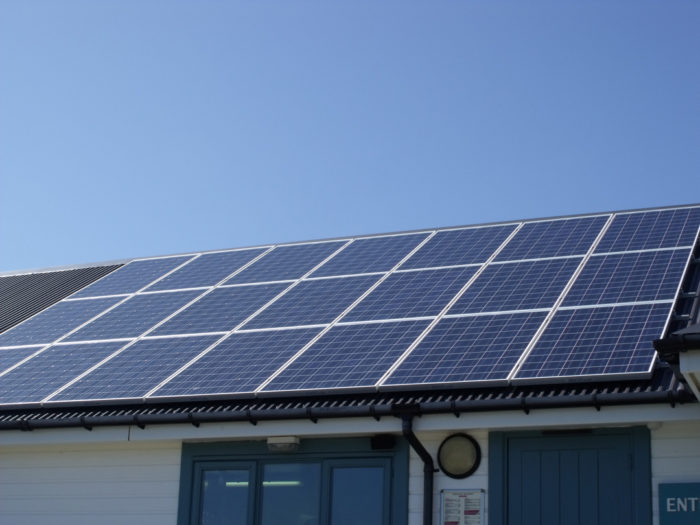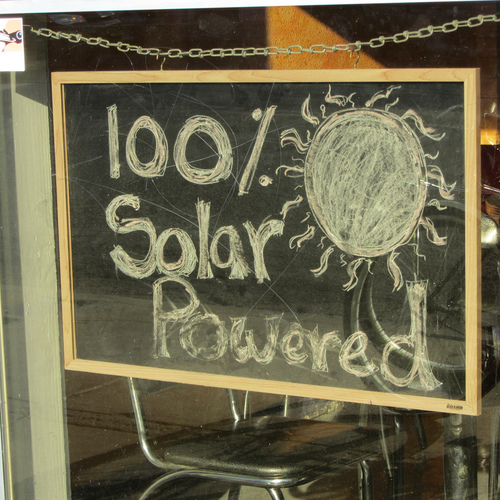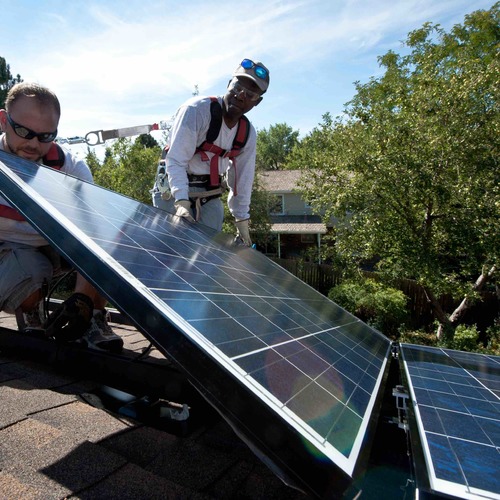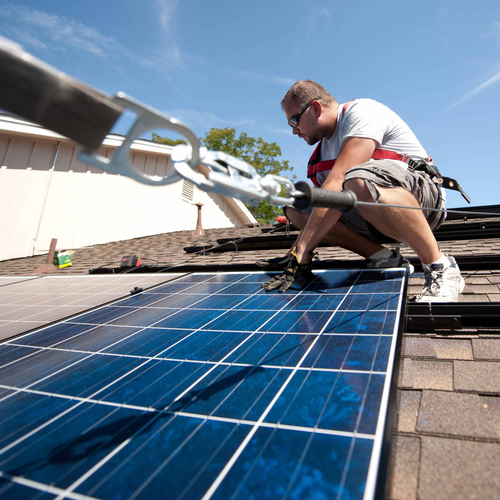
Image Credit: Elliott Brown via Flickr
The cost of solar energy continues to fall, so it is no surprise that more people are adopting solar.
This rapid growth of rooftop solar, however, has led many electric utilities to try to apply the brakes. A number have lobbied to change the net-metering policies that credit consumers for the excess solar power they generate. Does this make sense?
Solar net metering works akin to a bank account. You “deposit” unused energy (kilowatt-hours) generated by your system during the day onto the electric grid – that is, during those times when your solar panels generate more power than your home consumes. You then “withdraw” energy at night or when your system is not generating enough electricity.
Also like a bank account, your deposited energy is not just sitting in a vault; other utility customers who need electricity use your excess solar power at the time of deposit. When you withdraw the energy, it is generated by a power plant for you.
As simple as this process sounds, it has generated a huge debate within the electric power industry.
The electric industry makes an appealing argument that utilities should charge net metering customers for all these energy deposits and withdrawals. In promoting a change to the net metering law in Minnesota, for example, State Representative Pat Garofalo said solar customers are “able to use the grid without charge and this means higher rates for other consumers.”
On the other side of the argument, there is a compelling case that says utilities should let solar customers use the grid at no charge or even that utilities should provide incentives to solar customers. After all, photovoltaic systems produce the most during long sunny summer days when the demand for electricity is high and it costs more money to generate power. Thus, according to this argument, the excess solar generation deposited onto the grid during the day is more valuable than the electricity withdrawn at nighttime.
So which logic is more compelling? Is net metering a burdensome requirement or is it beneficial to everyone?
Last year I heard the president of a Midwestern utility speak about this burden solar created, and his logic seemed very good. So I looked at the electricity production data that were automatically collected by my own rooftop solar panels and compared it to the peak and off-peak electric rates that I pay. I then decided to systematically dig into the numbers for a large region in my home state of Pennsylvania and do a more scientific analysis – and the results surprised me.
Varying price for electricity
Pennsylvania has a deregulated market in which utilities distribute electricity rather than produce it. Most customers choose and pay a separate supplier for the generation of electricity from a power plant. When customers don’t make this choice, then utilities will purchase wholesale power – the cost that utilities pay to power generating companies – and then resell this power to consumers at a retail price.
During times of high demand, the price for power on the wholesale market goes up. It can even go up by over 1,000% within the same day or week.
Utilities and electric suppliers make daily predictions for the amount of energy needed by all customers so that electricity can be generated, purchased, and placed onto the grid. A very hot summer day, for instance, will require more energy to meet high air conditioning loads. Using short-term weather forecasting, one can also project the impact of solar energy on the overall demand for electricity on the day-ahead market.
I looked at the hourly price data for the day-ahead market for wholesale energy in the Pittsburgh region. And then I looked at solar production data for many photovoltaic arrays for this same region.
Using these data and a few assumptions about when a solar customer uses electricity, I found that the wholesale price for electricity deposited onto the grid is 20% greater than the wholesale price of electricity withdrawn from the grid at night or on bad weather days. In other words, solar energy allows suppliers and utilities to realize savings and increase profit margins, even though the solar customers are purchasing less electricity overall.
True value of solar?
But how would we quantify the full value of solar? The best way is to analyze the impact of solar that is not already priced into the market.
First, we assume that the price for a given demand remains constant. Then create a scenario or model in which a large amount of solar energy is placed onto the grid. This would create a noticeable decrease in the current daytime demand for electricity and a corresponding decrease in the price of electricity during these daytime hours.
For example, based on 2013 data, if Pennsylvania had solar energy provide 5% of all its electricity, a utility and its associated electric suppliers would see, according to my research, savings of $60 million per year for a region of 600,000 customers. (Five percent is quite a large amount of solar for Pennsylvania, where solar energy provides about 0.1% of electricity now.) At the same time, the utility and suppliers would see a decline in retail revenue of $45 million since solar customers would not be paying as much for their electricity. Amazingly, the savings are greater than the lost revenue.
For a typical utility or supplier, the net savings, according to my calculations, are $25 per customer per year. This is savings for every customer, not just solar customers. The few solar customers would be responsible for lowering the cost of electricity for all customers.
These savings are based only on the generation of electricity. There are additional similar savings for the distribution of electricity that I have not yet addressed. Just as it costs more to generate electricity when the demand is high, it also costs more to distribute electricity when the demand is high. In fact, sometimes it can cost so much more that utilities are willing to pay customers not to use electricity.
I should stress that even with solar energy, we need utilities and power generators. There will always be an infrastructure that needs to be supported and thus utilities and generators need to maintain a dependable revenue stream. However, as long as solar provides more savings than the decrease in revenue, there should be no problem for the electric industry. In fact, the electric industry could reinvest these additional profits to make the infrastructure more suitable for even larger amounts of solar.
Solar to the rescue?
If solar energy were adopted nationwide to 5%, 10%, or even higher levels, consumers will need to rethink their use of electricity. Now, regulators create policies in many states to encourage customers to lower their use of power during peak hours, shifting it instead to the evening. Instead of shifting electric use to nighttime hours, consumers would be encouraged to shift their use to late morning and midday hours.
During the day, power, rather than being most expensive, would be cheapest. At that time, generators and utilities would then have a new complaint: “Solar energy provides only the least valuable energy during the day, and we have to give back electricity to these customers at high nighttime rates — how unfair!”
When that time comes, generators and utilities will need to be reminded that their daytime costs would have been astronomically higher if not for solar energy, and even nighttime rates would have been higher if not for solar.
Richard Flarend is an associate professor of physics at Pennsylvania State University. This column was originally published at The Conversation.
Weekly Newsletter
Get building science and energy efficiency advice, plus special offers, in your inbox.















4 Comments
"Using the grid without charge" in MN
Eye roll. Perhaps I'm misreading, and I do realize this is a "guest blog post" so perhaps one shouldn't expect journalism, but if you're attempting to show multiple sides of an issue, please do some nominal amount of investigation. Really tired of this wholesale parroting of the blame-the-grid-tied-solar-customers horseshit.
In MN, grid-tied solar customers with Xcel have a net-metering agreement against a very small portion of charges. All the regular connection fees and sleazy sleight of hand fees remain. The next post will probably be from the Xcel legal team.
Minnesota net metering
Please don't roll your eyes.. If you read all the way through you'll see that after doing the research that you expect, I found that indeed the utilities are NOT justified in doing what they a few months ago in Minnesota. Thanks to the legal changes passed by the MN state legislature this year, MN now has perhaps the most solar-UNfriendly net metering laws in the nation. This article shows that in fact those very laws will actually cost utilities, and thus consumers MORE money than the net metering laws of other states. What I did say was that the argument given by the MN utilities was a compelling argument in the absence of any real data. Now that the data is in, their argument for extra net metering fees doesn't hold water.
The TRUE Value of Solar (again)
"But, how would we quantify the full value of solar?"
1) The portion used at the generating site (home) can have whatever "value" the owner assigns. It's hers. She had it installed. She operates it. She consumes it. No problem. No calculations.
2) The portion sent to the grid involves a supplier and a purchaser. The owner is the supplier and the utility is the purchaser. Now, however, she can't assign just any price (or terms) she wants. How do we assign a value? Indeed. How do we assign a value for anything? No matter how clever the analysis, the "value" would be a compromise between what she wants to get paid and what the utility is willing to pay. If she had an extension cord to her neighbor's electric car charging station, the "value" would be whatever price and terms she and the neighbor could establish. It would probably have to consider TIME among other things. If she had a second neighbor and another extension cord, there could well be another "true value" resulting from those negotiations.
3) As thought provoking and entertaining as the "true value" articles are, they need to include the buying side of the transaction as well as the selling side.
4) PV is to me a beautiful option for power generation. Period. It is not the only one, however, for dealing with hot summer peak electricity demand. There are economical options for drastically reducing air conditioning load that require no PV at all.
5) There's an "even handedness" in Mr. Flarend's article as well as a patient analytical approach that I find refreshing.
Response to W.D.
W.D.,
Q. "The owner [of the PV system] is the supplier and the utility is the purchaser. ... How do we assign a value? Indeed. How do we assign a value for anything?"
A. Some transactions allow for better price setting than others. When I bring a bushel of apples to the local farmers' market, there are (presumably) 6 other farmers selling apples, and (hopefully) 100 customers buying apples; the price depends on how much the customers want my apples, and the degree to which the other farmers are selling better or worse apples. There is competition.
My local utility has a monopoly, so there is no competition. There is nothing to prevent the local monopoly from offering me only 1 cent per kWh for my PV power -- nothing, that is, except the regulations established to prevent a monopoly supplier like an electric utility from taking advantage of the fact that electricity sellers have to no choice but to negotiate with a single purchaser. These regulations were established to prevent utilities from abusing the public trust -- abusing the position which the utility was granted by the community that regulates the utility.
Log in or create an account to post a comment.
Sign up Log in